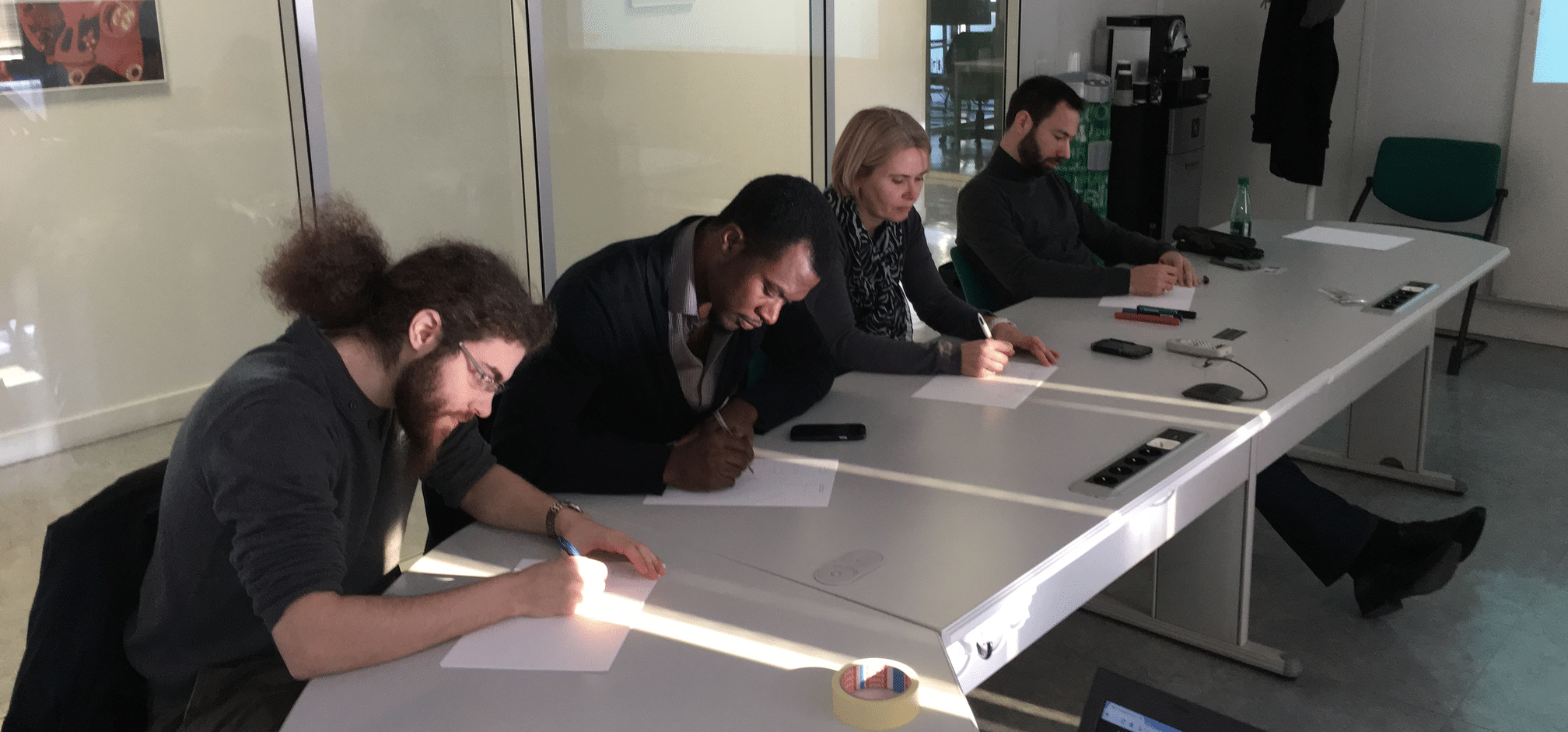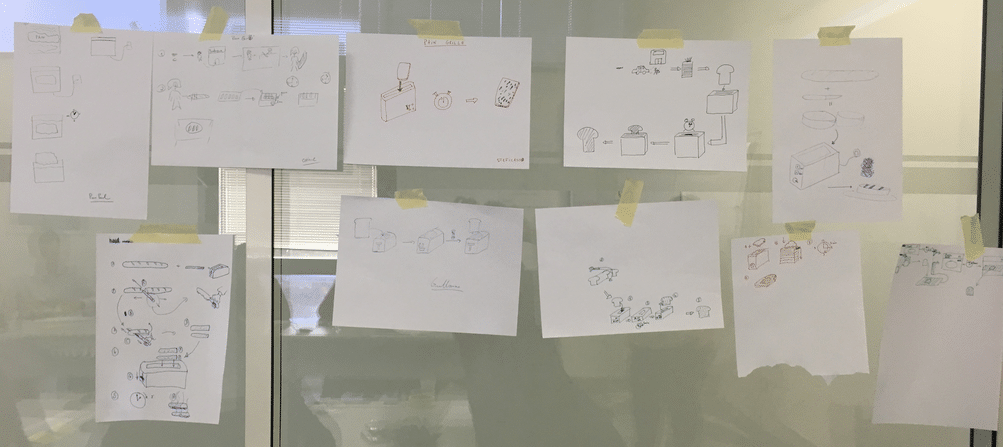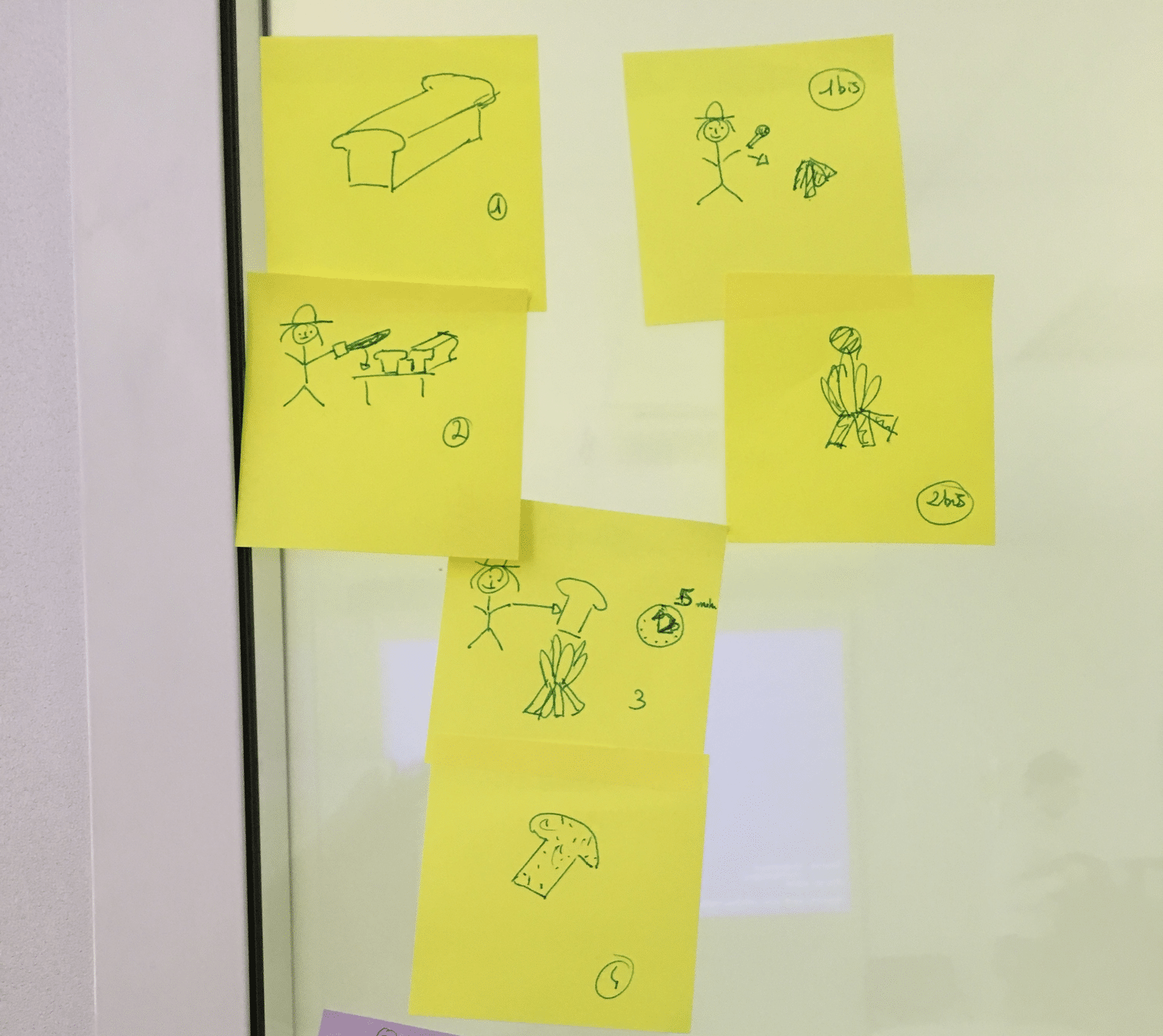
J’étais à la recherche d’un atelier à faire dans le cadre de ma mission permettant de sensibiliser les personnes aux pratiques de visualisation, de plus en plus en vogue dans la monde Agile en ce moment avec la facilitation graphique.
Je suis tombé sur cet atelier de Tom Wujec, le créateur du Marshmallow Challenge, qui décrit une approche de résolution de problèmes par la visualisation. J’ai décidé de le tester !
Etape 1 : Préparer le matériel
On a donc besoin :
- de marqueurs
- d’un paquet de feuilles A4
- de Post-it de différentes couleurs
- de plusieurs rouleaux de scotch de peintre
mais aussi :
- de quelques tables et chaises
- de murs libres sur lesquels vous pourrez travailler
Note: Il est important d’avoir suffisamment d’espace pour que tous les participants puissent voir les créations de tout le monde.
Etape 2 : Introduire l’atelier
Comme tout atelier de ce type, il me paraît important de toujours l’effectuer de manière informelle. Après tout, les participants sont là pour apprendre, pourquoi se contraindre avec une rigidité supplémentaire ? :-p
J’ai ainsi commencé en disant :
Bonjour à tous, merci d’être venus !
Aujourd’hui, nous allons apprendre à faire du pain grillé ! D’ailleurs, comment faites-vous habituellement ?
Etape 3 : Individuel / Feuille A4

J’ai alors distribué marqueurs et feuilles A4 puis j’ai invité chaque participant, en silence, à dessiner la manière dont il/elle faisait son pain grillé (toast en anglais) puis d’aller l’afficher au mur.
En voici le résultat :

Les participants ont été surpris de la diversité des représentations et cela a donné lieu à de bons éclats de rires ! En effet, on se rend bien compte que l’on parle bien de la même chose mais que chacun en a une représentation différente, ce qui est la clé de l’exercice.
C’est le moment d’analyser un peu plus en détails les résultats. J’invite alors les participants à réfléchir sur les points communs et les différences majeures entre toutes ces représentations.
Mise à part la touche artistique personnelle de chacun, on remarque qu’il apparaît dans chaque dessin un système de nœuds et de flèches permettant de structurer les étapes du processus de préparation du pain grillé – étant en présence d’une majorité d’ingénieurs, cela paraissait plutôt évident ! Ce formalisme commun a permis à tous de pouvoir comprendre la représentation de tout le monde.
Ainsi, c’est en regardant ce système de nœuds et de flèches que l’on peut observer une différence notable : le nombre. En effet, le nombre de groupes (nœud, flèche) est différent selon le niveau de détail exprimé par l’auteur – nous allions de 2 étapes à près de 10 dans notre cas.
Après quelques minutes d’échanges, j’ai posé la question suivante :
Et qu’en est-il de la personne souhaitant griller son pain – autrement dit, l’acteur principal du système ?
On remarque alors que pour la plupart du temps, ce sont les outils et le pain qui apparaissent, l’utilisateur ayant été souvent omis de la représentation. Cela semble être un cas courant pour des profils ingénieurs !
Outre le côté amusant de cette prise de conscience, cela amène à réfléchir à un sujet plus sérieux.
Pour qui le système a-t’il une utilité ?
En effet, si l’on se place du point de vue de l’utilisateur, cela n’influerait-il pas sur notre perception du processus à décrire ? Notre solution, dans ce cas liée à un véritable besoin, ne serait-elle pas plus pertinente ?
Etape 4 : Individuel / Post-it
Nous enchaînons alors avec l’étape suivante. J’invite cette fois-ci les participants à changer leur support en remplaçant la feuille A4 par des Post-it. Même consigne donc : « Dessinez-moi, en silence, la manière dont vous faites du pain grillé. »
Ah si, je rajoute souvent cette phrase maintenant dans les ateliers où des Post-it sont utilisés (quasiment tout le temps donc ! :-p) :
N’oubliez pas que les Post-it sont comme des balles de golf, ils sont faits pour être utilisés ! 😉
Cela permet aux participants d’agir en toute âme et conscience et donne un cadre clair sur le fait que l’utilisation de Post-it n’est pas restreinte. On privilégie ainsi la clarté à la concentration d’information.
Lorsque les participants ont terminé, je les encourage à venir afficher leur résultat sur le mur dont voici un exemple :

Note : on remarquera la présence de l’utilisateur cette fois ! 😉
J’invite les participants à partager leur ressenti sur les différences par rapport à l’étape précédente sur feuille A4.
La tendance générale est la représentation d’une étape par Post-it.
En effet, la différence notable est que les participants ont plus facilement la possibilité de modifier leur création en déplaçant, ajoutant, supprimant des Post-it, ce qui n’était pas le cas avec la feuille A4 qui d’ailleurs ne présentait quasiment aucune rature. Maintenant, peut-être que les participants avaient effectué des brouillons préalables avant de remettre les choses au propre mais le temps limité tend à réduire cette hypothèse.
Le support plus flexible apporté par le Post-it permet ainsi d’accompagner la construction du résultat avec la réflexion en continu de l’auteur.
Tom Wujec, dans son TED, explique que la plupart du temps à cette étape, le nombre de nœuds augmente. En effet, en isolant chaque étape sur un Post-it, il est plus facile de voir s’il y a des trous ou de compléter avec des éléments de détail sans surcharger l’existant.
Cependant, dans notre cas, la différence n’était pas si notable. Peut-être cela dépend-il du profil des participants ?
Etape 5 : Groupe / Post-it
Pour cette dernière partie d’atelier, j’invite les participants à travailler en groupe (4 à 6 personnes).
La problématique est la même : ils doivent construire le processus décrivant comment l’équipe décide de griller son pain, et tout cela… en silence ! En effet, l’animation d’un atelier collaboratif de ce type génère beaucoup de bruit, alors un peu de calme ne fera pas de mal ! :-p
Plaisanteries mises à part, l’utilisation des mots pour communiquer peut engendrer de multiples débats inutiles, c’est pourquoi cette expérience pouvait être enrichissante à la fois pour les participants mais aussi pour l’animateur. Il pourrait également être intéressant de varier les plaisirs dans les équipes : moitié du temps en silence puis le reste avec communication orale autorisée, une équipe en silence et l’autre en communication orale…
J’ai également précisé qu’ils pouvaient utiliser leurs créations de la précédente étape et construire de nouveaux éléments s’ils en ressentaient le besoin.
Voici en vidéo l’expérience d’une des équipes :
Timeline des éléments marquants
(00:00 – 00:47) : Synchronisation de l’équipe sur le premier élément. Une comparaison s’effectue, facilitée par la maniabilité du Post-it.
(01: 14) : L’équipe recherche le second élément et continue à observer les options qui sont à leur disposition avant de le sélectionner.
(01:24) : Le troisième élément arrive dans le système et un réagencement est proposé. La créativité est en marche !
(01:34) : Le système de flèches apparaît pour faciliter la compréhension.
(02:47) : L’équipe clarifie son espace de travail tout en restant focalisée sur l’objectif.
(03:13) : Un moment de doute dans l’équipe.
(03:33) : Éclaircissement du doute par un ajout d’un élément de détail.
(03:42) : Structuration par branches.
(05:13) : Correction instantanée.
(05:46) : Fin de l’expérience.
En guise de débriefing, voici les sujets sur lesquels j’ai invité les équipes à réfléchir :
Y-a t’il une personne (disons Type A) qui a une majorité de ses propositions initiales dans le processus final ?
Y-a t’il une personne (disons Type B) qui a peu ou aucune de ses propositions initiales dans le processus final ?
J’ai ainsi demandé aux personnes (Type A et B) concernées comment elles se sentaient vis à vis du résultat.
- Type A : Elles sont généralement satisfaites sachant que c’est finalement une grande partie de leurs idées qui ont été acceptées par le groupe.
- Type B : Le point intéressant est que ces personnes étaient également globalement satisfaites du résultat malgré le fait que peu ou aucune de leurs idées initiales n’aient été retenues par l’équipe. La différence est que même si leur proposition initiale n’a pas été sélectionnée, c’est leur avis qui a su être pris en compte pour la prise de décision en tant qu’équipe. Ainsi le résultat final leur appartient tout autant qu’aux personnes de Type A, ce qui favoriserait tout autant leur engagement vis à vis de l’application de ce processus.
Conclusion
Cet atelier permet efficacement de sensibiliser à la résolution de problèmes complexes en groupe par la visualisation en partant d’un sujet banal comme griller du pain. Il démontre simplement, par le biais de ses différentes étapes, qu’il est facile d’avoir une vue différente sur un même problème et donc qu’il est important d’avoir une compréhension partagée : l’affichage sur un mur à la vue de tous est alors un moyen très efficace ! 😉
En impliquant l’ensemble du groupe dans la réflexion, on favorise la créativité, l’engagement puis potentiellement l’adoption de la solution ou de l’expérimentation a effectuer vis à vis de la problématique : après tout c’est le fruit d’une réflexion du groupe pour le groupe !
Dans mon cas, j’ai seulement reproduit l’atelier présenté par Tom Wujec dans sa vidéo pour sensibiliser les participants à cette approche participative, cependant il peut être intéressant de le combiner avec une application pratique sur un vrai problème du groupe lors d’une session suivante. Prévoir environ 1h30 par session.
Grands remerciements aux participants pour leur implication et leur bonne humeur ! 🙂
Vous pouvez retrouver le TED de Tom Wujec ici.






